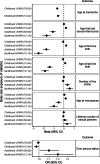Establishing the relationships between adiposity and reproductive factors: a multivariable Mendelian randomization analysis
- PMID: 37697382
- PMCID: PMC10496263
- DOI: 10.1186/s12916-023-03051-x
Establishing the relationships between adiposity and reproductive factors: a multivariable Mendelian randomization analysis
Abstract
Background: Few studies have investigated associations between adiposity and reproductive factors using causal methods, both of which have a number of consequences on women's health. Here we assess whether adiposity at different points in the lifecourse affects reproductive factors differently and independently, and the plausibility of the impact of reproductive factors on adiposity.
Methods: We used genetic data from UK Biobank (273,238 women) and other consortia (EGG, GIANT, ReproGen and SSGAC) for eight reproductive factors: age at menarche, age at menopause, age at first birth, age at last birth, number of births, being parous, age first had sexual intercourse and lifetime number of sexual partners, and two adiposity traits: childhood and adulthood body size. We applied multivariable Mendelian randomization to account for genetic correlation and to estimate the causal effects of childhood and adulthood adiposity, independently of each other, on reproductive factors. Additionally, we estimated the effects of reproductive factors, independently of other relevant reproductive factors, on adulthood adiposity.
Results: We found a higher childhood body size leads to an earlier age at menarche, and an earlier age at menarche leads to a higher adulthood body size. Furthermore, we find contrasting and independent effects of childhood and adulthood body size on age at first birth (beta 0.22 SD (95% confidence interval: 0.14, 0.31) vs - 2.49 (- 2.93, - 2.06) per 1 SD increase), age at last birth (0.13 (0.06,0.21) vs - 1.86 (- 2.23, - 1.48) per 1 SD increase), age at menopause (0.17 (0.09, 0.25) vs - 0.99 (- 1.39, - 0.59) per 1 SD increase), and likelihood of having children (Odds ratio 0.97 (0.95, 1.00) vs 1.20 (1.06, 1.37) per 1 SD increase).
Conclusions: Our findings demonstrate the importance of considering a lifecourse approach when investigating the inter-relationships between adiposity measures and reproductive events, as well as the use of 'age specific' genetic instruments when evaluating lifecourse hypotheses in a Mendelian randomization framework.
Keywords: Adiposity; Mendelian randomization; Reproductive factors; UK Biobank.
© 2023. BioMed Central Ltd., part of Springer Nature.
Conflict of interest statement
The authors declare that they have no competing interests.
Figures


Similar articles
-
Chain effect of lifecourse reproductive characteristics and body fat and muscle on cardiovascular disease in women: a Mendelian randomization study.Cardiovasc Diabetol. 2025 Apr 18;24(1):170. doi: 10.1186/s12933-025-02681-0. Cardiovasc Diabetol. 2025. PMID: 40251560 Free PMC article.
-
The relationships between women's reproductive factors: a Mendelian randomisation analysis.BMC Med. 2022 Mar 24;20(1):103. doi: 10.1186/s12916-022-02293-5. BMC Med. 2022. PMID: 35321746 Free PMC article.
-
Age at menarche, age at natural menopause, and risk of rheumatoid arthritis - a Mendelian randomization study.Arthritis Res Ther. 2021 Apr 9;23(1):108. doi: 10.1186/s13075-021-02495-x. Arthritis Res Ther. 2021. PMID: 33836822 Free PMC article.
-
Adiposity in relation to age at menarche and other reproductive factors among 300 000 Chinese women: findings from China Kadoorie Biobank study.Int J Epidemiol. 2017 Apr 1;46(2):502-512. doi: 10.1093/ije/dyw165. Int J Epidemiol. 2017. PMID: 27524817 Free PMC article.
-
Childhood, adolescent, and adulthood adiposity are associated with risk of PCOS: a Mendelian randomization study with meta-analysis.Hum Reprod. 2023 Jun 1;38(6):1168-1182. doi: 10.1093/humrep/dead053. Hum Reprod. 2023. PMID: 37015099 Free PMC article.
Cited by
-
Mammographic density mediates the protective effect of early-life body size on breast cancer risk.Nat Commun. 2024 May 13;15(1):4021. doi: 10.1038/s41467-024-48105-7. Nat Commun. 2024. PMID: 38740751 Free PMC article.
-
Methodological approaches, challenges, and opportunities in the application of Mendelian randomisation to lifecourse epidemiology: A systematic literature review.Eur J Epidemiol. 2024 May;39(5):501-520. doi: 10.1007/s10654-023-01032-1. Epub 2023 Nov 8. Eur J Epidemiol. 2024. PMID: 37938447 Free PMC article.
-
Chain effect of lifecourse reproductive characteristics and body fat and muscle on cardiovascular disease in women: a Mendelian randomization study.Cardiovasc Diabetol. 2025 Apr 18;24(1):170. doi: 10.1186/s12933-025-02681-0. Cardiovasc Diabetol. 2025. PMID: 40251560 Free PMC article.
References
-
- Peters SA, Huxley RR, Woodward M. Women's reproductive health factors and body adiposity: findings from the UK Biobank. Int J Obes (Lond) 2016;40(5):803–808. - PubMed
-
- Juul F, Chang VW, Brar P, Parekh N. Birth weight, early life weight gain and age at menarche: a systematic review of longitudinal studies. Obes Rev. 2017;18(11):1272–1288. - PubMed
-
- Zhu D, Chung HF, Pandeya N, Dobson AJ, Kuh D, Crawford SL, Gold EB, Avis NE, Giles GG, Bruinsma F, et al. Body mass index and age at natural menopause: an international pooled analysis of 11 prospective studies. Eur J Epidemiol. 2018;33(8):699–710. - PubMed
Publication types
MeSH terms
Grants and funding
LinkOut - more resources
Full Text Sources

